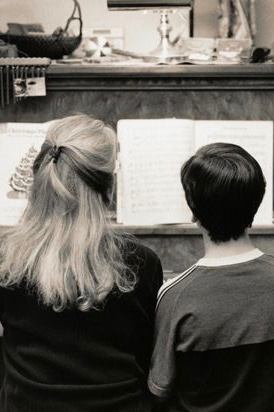
Variations on a Theme
February 15, 2020 | The Wall Street Journal
When a musician sits down and tries to play something for the first time, an extraordinary thing can happen, writes the critic Philip Kennicott. If he or she has heard the music before but never attempted it, a feeling not unlike the flush of romantic love can occur. For a few carefree minutes, there is no worrying over mistakes or fear of the hard work ahead: There is only novel recognition. “The conjuring of these voices with your own hands gives them a surfeit of charm, rather like meeting someone in the flesh after having seen only a photograph.”
Mr. Kennicott experienced this sensation after placing the “Goldberg Variations” on his piano stand at a fraught moment several years ago. He bought Bach’s famous score after his mother died. A promising pianist in his youth who decided to pursue journalism (he is the senior art and architecture critic for the Washington Post), Mr. Kennicott took up the “Goldbergs” to test his waning abilities, maintain a connection with his lost parent, and confront death. “Nothing organizes our world quite like grief,” he writes. “It puts our priorities in order, and makes us impatient with trivial things.” There isn’t anything trivial about the music of Bach, whose keyboard masterpiece defines the very limits of artistic achievement.
In “Counterpoint: A Memoir of Bach and Mourning,” Mr. Kennicott chronicles how music helped him grieve. It is a book full of arresting insights about the way music permeates our lives, as well as heartbreaking reflections on the wounds a parent can inflict on a child. Mr. Kennicott’s mother “was unhappy and died that way, unfulfilled and angry about what she sensed was a wasted life. She had wanted to be a violinist.” Passages describing her emotional and physical abuse of her children—especially her shocking attack on a 14-year-old Mr. Kennicott for leaving his snow boots in the wrong place one day—are painful to read.
Yet without gainsaying his mother’s transgressions, Mr. Kennicott confronts her memory in a spirit of generosity. With an adult’s perspective, he notes with gratitude her willingness to organize refreshments after his piano recitals, though she hated such social functions and the chores they entailed. He recounts the way she put off a medical appointment so that he could appear in a performance. Invoking his childhood nickname, he wistfully remembers how she would overhear him practicing and say, “That’s nice, Flip.” In the context of his current project, he regrets that she will never hear him play Bach.
The book weaves together memories of Mr. Kennicott’s childhood and his efforts to learn the “Goldberg Variations.” The experience lasted five years and yielded a half-dozen variations (of 30) that found their way into his fingers. Anyone who has ever struggled to master a piece of serious music will understand his description of the precarious balance this effort entails between freedom and control. Would-be performers will also read with interest Mr. Kennicott’s discussion of what it means to “know” a piece. He relates the “elusive sense of a yet deeper understanding lurking beneath the notes on the page. The musician asks himself: Have I understood it when I can play it? Or when I can play it flawlessly? Or when I have memorized it? Or when I can analyze its structure?” For all but the virtuoso, this pursuit can become a bottomless well of frustration and doubt.
Such questions resonate particularly strongly in the case of Bach. The mathematical precision, the vast output across forms, the fearsome difficulty and harmonic innovations that anticipated music centuries in the future—these render Bach not merely an unknowable genius but a godlike one. The pianist Jeremy Denk once observed that, while other composers seemed to write novels, Bach wrote nonfiction. Yet Mr. Kennicott asserts that Bach, who was both industrious and devout, would have scoffed at the notion that his music was the product of divinity rather than craft. And regardless of the formal symmetry of Bach’s masterworks, Mr. Kennicott persuasively contends that the ear takes them one bar at a time, just like any composer’s.
The “Goldberg Variations” end by repeating the aria with which they begin: a simple song of exquisite loveliness. In this book’s context of time and loss, the aria is almost unbearably poignant, an emblem of the author’s return to his own past and his mother’s memory. Although the notes are the same both times, there is an ineffable change hearing them again at the end of the variations, as though one had been on a journey that encompassed life itself. “How much time would it take to really learn them?” Mr. Kennicott asks. “All the time I have, and even more.”